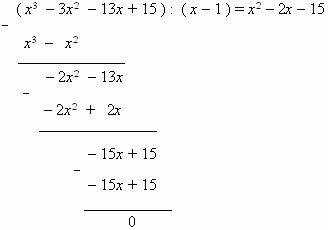Equations of higher degrees
Biquadratic equation. Cubic equation.
| 1. |
Some kinds of the higher degrees equations may be solved using a
quadratic equation. Sometimes one can resolve the left-hand side of
equation to factors, each of them is a polynomial of the degree not
higher than second. Then, equaling each of them to zero and solving all
these quadratic and / or linear equations, we’ll receive all roots of
the original equation.
E x a m p l e . Solve an equation: 3 x 4 + 6 x 3 – 9 x 2 = 0 . S o l u ti o n . Resolve the left-hand side of this equation to factors: x 2 ( 3 x 2 + 6 x – 9 ) . Solve the equation: x 2 = 0; it has two equal roots: x 1 = x 2 = 0 . Now we solve the equation: 3 x 2 + 6 x – 9 = 0, and receive: x 3 = 1 and x 4 = – 3 . Thus, the original equation has four roots: x 1 = x 2 = 0 ; x 3 = 1 ; x 4 = – 3 . |
||||
| 2. |
If an equation has the shape:
ax 2 n + bx n + c = 0 ,
it is reduced to an quadratic equation by the exchange:
x n = z ;
really, after this exchange we receive: az 2 + bz + c = 0 .
E x a m p l e . Consider the equation:
x 4 – 13 x 2 + 36 = 0 .
Exchange: x 2 = z . After this we receive:
z 2 – 13 z + 36 = 0 .
Its roots are: z 1 = 4 and z 2 = 9. Now we solve the equations: x 2 = 4 and x 2 = 9 . They have the roots correspondingly: x 1 = 2 , x 2 = – 2 , x 3 = 3 ; x 4 = – 3 . These numbers are the roots of the original equation ( check this, please ! ).
Any equation of the shape: ax 4 + bx 2 + c = 0 is called a biquadratic equation. It is reduced to quadratic equations by using the exchange: x 2 = z .
E x a m p l e . Solve the biquadratic equation: 3 x 4 – 123 x 2 + 1200 = 0 .
S o l u t i o n . Exchanging: x 2 = z , and solving the equation: 3 z 2 – 123 z + 1200 = 0 , we’ll receive:
hence, z 1 = 25 and z 2 = 16 . Using our exchange, we receive:
x
2
=
25 and
x
2
=
16, hence,
x
1
=
5,
x
2
=
–5,
x
3
=
4,
x
4
=
– 4.
|
||||
| 3. |
A
cubic equation
is the third
degree equation; its general shape is:
The known Cardano’s formulas for solution of this kind equations are very difficult and almost aren’t used in practice. So, we recommend another way to solve the third degree equations.
|

